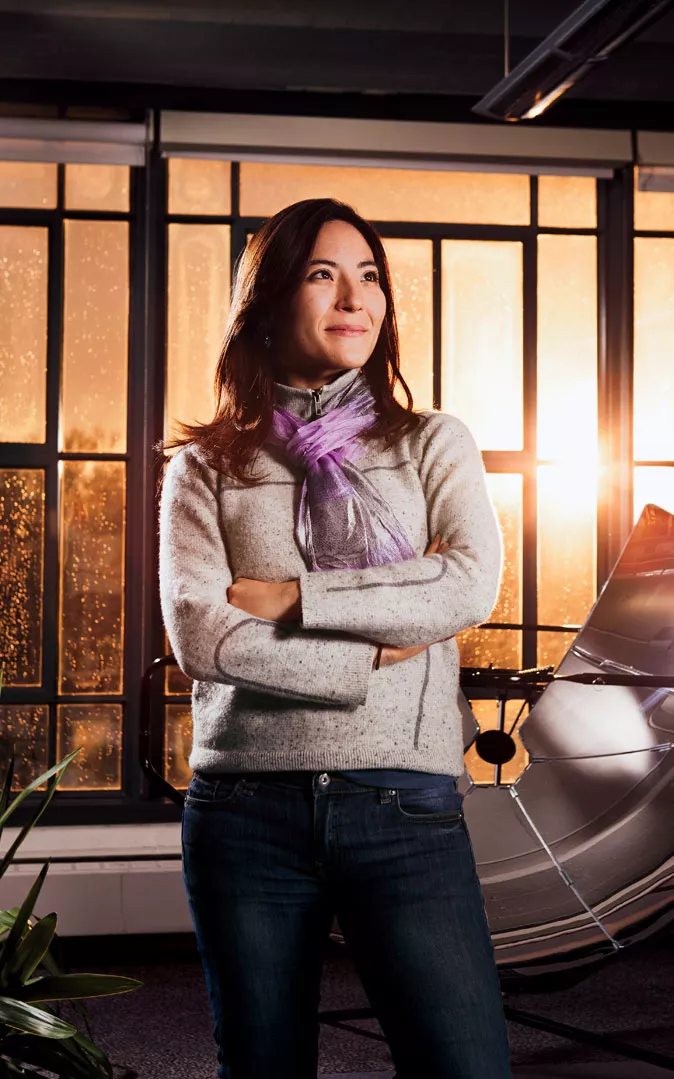Dr. Catlin Powers, Eco-Engineer
Himalayan villagers needed a solar cooker that could perform in sandstorms and below-freezing temperatures

Dr. Catlin Powers, cofounder and CEO of One Earth Designs. | Photo by Josh Andrus.
Adapted from an interview with Catlin Powers by Erik Hoffner.
I went into the Himalayas as an undergraduate to study climate change. Local people asked why my team was in the region, so I struggled to find the words "climate change" in Tibetan. Finally, I came up with "we are studying smoke in the sky." Everyone burst out laughing: "What a ridiculous thing to do. The sky is blue, but there's all this smoke in our homes." They brought me inside, and the air was thick and yellow, just searing to breathe. The air-quality monitors attached to my jacket indicated that the air was 10 times worse than what I'd recently measured in Beijing.
Looking into the issue, I found that globally more than 4 million people die every year from smoky indoor air. It made me rethink my purpose. I left my undergraduate program and started traveling with the nomads. One day an elder said that we needed to look at the problem of fuel, because every year the women had to walk farther to find it. The government once handed out solar cookers, he said, but they broke quickly. "We need a more durable, portable, and safe way to do solar cooking," he said. I took that as a challenge.
We started One Earth Designs without any cash. We just began making the SolSource cookers by hand, but the quality wasn't good. It became clear that we needed a better process. We vetted hundreds of factories to find ones that met our social and environmental standards. None would take our order because it was so small. When I talked with the factory bosses, I found that some of them had grown up in homes that faced the same challenge. Finally, one in southern China decided to work with us.
Our goal was to make the SolSource as powerful and easy to cook on as a traditional stove. It had to perform at below-freezing temperatures and in high winds and sandstorms. We did lots of systematic testing in real-life conditions as well as 30 years' worth of accelerated weather testing at a third-party facility that specializes in product-failure tests.
Recently, I revisited the community I'd spent a lot of time in. A woman grabbed me and showed me her SolSource. "There are two things that I love about this. One is that my younger daughters are going to school because now they don't have to stay home to collect wood. Second, my husband is finally taking an interest in cooking. He shows it off to his friends!"
I've enjoyed building things since I was little and have a notebook filled with technology ideas that wake me up in the middle of the night. Eventually, if One Earth Designs gets to the stage where someone else would run it better than I, maybe I'll work on some of those other technologies. Or maybe we'll get big enough that we'll make them ourselves.
At the moment, my passion is to figure out how to store solar energy in better ways. There are many systems for using photovoltaics to convert light to electricity. But much of the energy we use in our households is actually thermal, for activities like cooking and heating. So if we can find a way to harness solar energy to supply that thermal demand and store it for prolonged periods—such as at night, during the winter, or in the monsoon season—that opens up a tremendous opportunity for a much cleaner and more efficient way of powering homes around the world.
I grew up in many different places around the world: Peru, Mexico, China, South Africa, and California. Both my father and my mother are teachers, so we were always off doing research or teaching. I was exposed to a lot of cultures, and because it wasn't practical to get traditional schooling, I got involved with all kinds of community organizations. That was my introduction to change-making work, and I thought it was a fantastic way to grow up.
I'm a stubborn optimist and find it hard to say no to opportunities. Every day, I'm able to put my energy in a direction that feels good for the world to be moving in. I am fortunate to be in a position to do that, but many people don't have the option. On the flip side, many believe they don't have that option when they do.
This article was funded by the Sierra Club's Global Population and Environment Program (sierraclub.org/population).
 The Magazine of The Sierra Club
The Magazine of The Sierra Club



